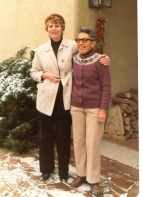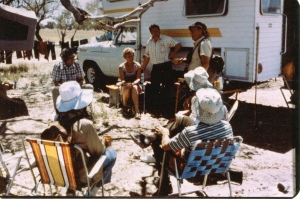The dead leave us starving with mouths full of love. (Michaels 1997: 20)
Much of my writing is autobiographically based. Pickle to Pie, although published as a novel was based on my father’s life. This second book is about my thirty-five year pen-friendship with an older American poet. I was three quarters through writing our story when Mickey died.
My writer’s journal remained closed; the novel frozen. How to write the unsayable—to write through silence into a safe space? My mediated text, balanced between fact and fiction, meant that half of my writing was in the real world. I was telling another woman’s story as well as my own. I had worked through many writing issues, and told numerous stories of literary and personal goals, but I came full circle when faced with Mickey’s death. At the heart of the novel were two real women. Now, one was lost and I was grieving.
I am a writer and writing is the way I make sense of the world. Therefore I could not understand my inability to write. Mickey’s death was not my first introduction to grief. I had grieved for aunts, uncles and close friends, and the ultimate orphaning loss of both parents. During those difficult times, writing had been my salvation.
I write because then I do not have to speak. I write with the colours of memory. I write because I believe it can create a path in the darkness. So why was I suffering from writer’s block? Because, when Mickey died I was in the middle of writing a fictionalised account of our friendship. I was immersed in the autoethnographic exploration of the memories encompassing both of our lives. This grief was different from any others I had experienced. As Didion reveals in The Year of Magical Thinking (2005) each individual grief is ‘a place none of us know until it happens’ (Didion 2005: 188). T
The voices of others. ‘She was ninety-three years old’. ‘She had a long life’. ‘She didn’t suffer’. ‘You’re still upset?’ ‘Get over it’. ‘Move on’. ‘Mickey who?’ (Journal 4 2010: 126)
Before I could bring myself to write, however, I had to come to terms with my recent loss. Over ninety years old, recently hospitalised, Mickey had refused to eat; she had willed herself to die. I found this out by chance a week after she had died and my creative drive faltered. There was no funeral to attend nor a healing ceremony, just a hole that could not be filled. I gathered black around me and grieved.
I returned to my journal. When I did not want to write, when I was feeling brain-dead, writing about the ordinariness of life without sorting, sifting, editing, connected me with the living and with the dead (Adams 1998: 4). It created a place to be in ordinary conversation with anyone—from myself to my old penfriend. It connected me to Virginia Woolf, Elizabeth Jolley, Margaret Atwood and Margaretta Jolly. I could smell, see, touch and taste the story waiting for its ending. T
he earphones hurt my ears and my fingers tremble as I turn on the tape recorder. Mickey’s highly opinionated deep voice permeates my being. Informal conversations we had in 2002. There are so few. When the tape recorder was on, she rarely wanted to talk, and the best conversations were when I turned it off. For me, it is the sound of her strong, opinionated voice that is important. It triggers deep emotions. I must believe the writing will come to life in her voice. Not mine. Yet woven within the writing is my story. Mickey and I in context with history, revealed via my recollections. (Journal 4 2010: 233)
Life is a tapestry and death leaves a hole. I looked at the empty space and realised I had never willingly allowed any empty spaces in my life. Life had been about hanging on to what you had. Anything I had ever let go had claw marks on it. Yet this empty space was different. With wonder, I began to see it as a creative space, an opportunity to move on through the process of creating (Riggs 2007). It became filled with possibilities. I began to weave the tapestry bigger so the hole was less obvious. Writing the ending to the story allowed me to make visible the size and shape of my grief and through language I could give substance to Mickey.
In May, in water-cooler conversation with another PhD candidate, for the first time I talked about Martha the character in the novel and thought of her as Martha, not Mickey. At that point I realised that a huge shift had taken place: a distancing.
There is a break between friend and character. I can write Martha, talk about Martha, think Martha and keep Mickey, friend and mentor safely tucked in my heart. I’m remembering the woman and writing the character (Journal 5 2011: 29)
But was I writing from an idealised memory of Mickey? Had my grief and mourning turned the novel into a representation of somebody perfect and had I ignored imperfections? ‘Hens Lay, People Lie’ was once again in danger of becoming a hymn of praise—until I remembered Mickey’s opinionated honesty. The character Martha now strides through the pages of the novel warts and all.
A motivating factor in my decision to include Mickey’s death within the novel was the belief that writing about my own experience would not only create a way through grief for me, but would also enable other bereaved writers to ‘witness the experience of reconstructing [their] own map’ (Frank 1997: 17) for writing from mourning. Louise DeSalvo’s writing (1999: 206) reinforced my belief that my story would help others to cope with grief and mourning. It was emotionally challenging to follow Caroline Ellis and the other exponents of emotive autoethnography, and reveal a vulnerable self. Whenever I wavered I thought of Hélène Cixous, Virginia Woolf and Laurel Richardson.
To me my texts are elements of a whole which interweaves my own story, are the seasons, days in the Great Year of my life. (Cixous 1994: xv)
Writing is what I do, in spite of the problems. What I had to reclaim was the sheer joy of writing; the intimate relationship between me and the page. Through this practice I hold communion with my deepest self. I did not want to bury Mickey or to praise her, but ‘…to exalt her exceptional contribution to my own happiness and belief in the worthiness of life itself by the testimony of her own’ (Barthes 2010: 260). Perhaps this is the gift of every daughter—even a proxy one. The blackness of loss and grief woven through the text added depth to the colours already woven through the story.
I have always wanted wings. To fly where I belong, to become who I am…winged and moon-swayed. (Griffiths 2011: 3)
Ultimately I learnt to trust myself and find my own safe space to write from mourning. On my magic carpet I let my imagination soar—to follow Jay Griffiths and fly to the moon, to live in my imagination, to experiment with plot and characters, to swoop and fly and write from multiple stray moons.
Morning sun gilds the topmost leaves of the melaleuca gums. I drag my kayak out onto the lake. Suspended between water and sky, my oar dips into reflected clouds. Between two worlds I find the end to our story. (Journal 5 2012: 233)





Very moving Glenice and will be a great help to other writers – thank you:)
LikeLike
Blogging coming naturally now. You will have a me,our from this eventually. Keep going.
LikeLike
Memoir…bloody auto ‘ forget’! Lol.
LikeLike
Thanks for visiting my blog
LikeLike
Pingback: Throwing Sticks and Skipping Stones | Writers and their stories